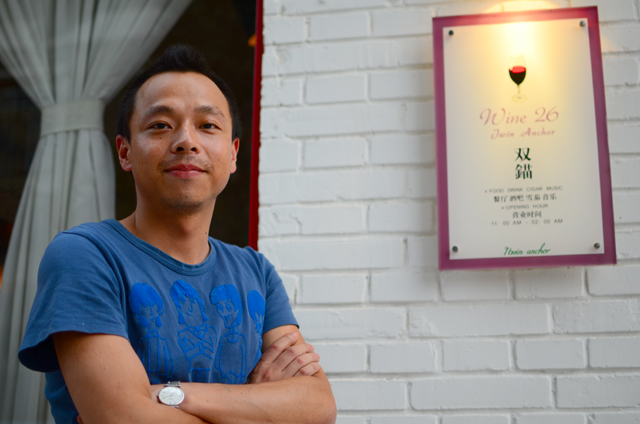China’s Burgeoning Wine Culture

Wine 26 Twin Anchor owner Wang Ye Qing opened his first restaurant at age 23, but said he still considers himself new to the world of fine wine. Photo by Lara Berendt
By Lara Berendt
For Reporting Texas and ChinaInFocus.com
Within the narrow alleys of Beijing’s historic Mao’er neighborhood, a wine bar with chic, minimalistic décor stands out amid gray stone facades. Wine 26 Twin Anchor is the second venture from Wang Ye Qing, 30, who is part of a new generation of Chinese wine entrepreneurs.
Wang launched his first business in the city’s thronging Houhai tourist district, but noise and crowds drove him to open a second bar in this quiet spot a year ago, he said. At Wine 26, he serves about 50 mid-priced wines primarily to tourists and lodgers from area youth hostels.
China’s market for imported wine is quickly expanding. Thirty years ago, alcohol consumption was limited to beer and baijiu, a white grain liquor, said Edward Ragg, co-founder of Dragon Phoenix Fine Wine Consulting and an associate professor at Tsinghua University. Today, as Chinese disposable income levels increase, more consumers are tasting and developing an affinity for imported wines. Imports grew 60 percent last year, from about 10 million cases in 2009 to 16 million in 2010, Ragg said.
Chinese consumers approach wine differently, depending largely on age and income level, he said. Older generations are often guided by high-status labels, while younger drinkers with limited budgets are more open to tasting a variety of wines to determine which ones they prefer.
“It is the younger generation that is genuinely developing palates for wine,” Ragg said. “The older generation, generally speaking, [is] not that interested in learning about wine itself.”
At present, Chinese palates gravitate toward off-dry, or slightly sweet, wines made from grapes such as Gewürztraminer, Riesling, Pinot Noir, Shiraz and Tempranillo, Ragg said. French and Australian imports predominate, followed by Chilean, Italian and Spanish imports.
A few blocks from Wine 26, behind two small, ornate red doors, a gleaming glass wall reveals a tasting room just past a courtyard oasis. Inside Cambulac Italian Wine Merchants, floor to ceiling wine racks and fresh flowers complement the wholesaler’s high-end portfolio.
Cambulac sells bottles from about $50 to more than $900, mainly to state-owned enterprises and government ministries, said the manager, who asked to be identified only as Zhang.
Most Chinese associate fine wine with France, Zhang said, but he works to promote the idea that Italian wines are also worthy, and people’s perceptions are changing. Zhang said he hopes to someday visit his favorite wine-making regions, such as Piedmont in Italy.
At Wine 26, Wang’s approach to wine might cause some Westerners to balk. For instance, he doesn’t subscribe to rules that dictate which wine to drink with a specific food, and said the best wines are always the most expensive ones.
He spoke of a future when wine is as much a part of Chinese daily life as tea has been for millennia. As for his own ambitions, the restaurateur said this is a prosperous age for China’s fast-developing wine industry, but that he plans to relax and “play” for a while before undertaking any new ventures.